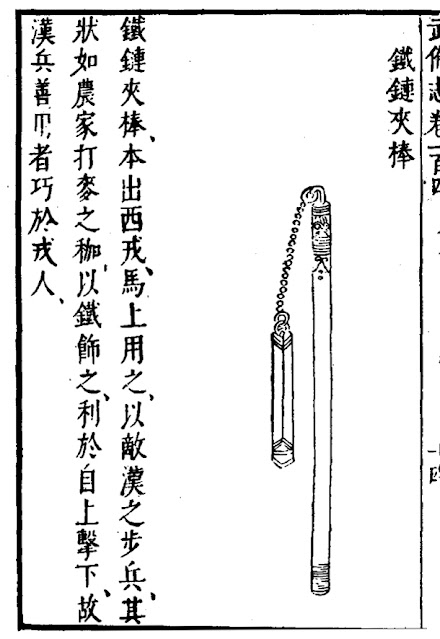Tie Lian Jia Bang (鐵鏈夾棒, lit. 'Iron chain with clubs')
 |
| Drawing of a Tie Lian Jia Bang, from 'Wu Bei Zhi (《武備志》)'. |
Tie Lian Jia Bang is the Chinese version of two-handed infantry flail. It is also known as
Lian Ting (連梃, lit. 'Linked staff'),
Lian Jia Bang (連耞棒), and several other names.
Early references of this weapon can be found in the works of Warring States period
Mo Zi (《墨子》) and Tang period
Tong Dian (《通典》). However, according to Song period
Wu Jing Zong Yao (《武經總要》), this weapon originated from a specialised cavalry weapon used by the nomadic enemies of China.
 |
| A pair of flails, from 'Huang Chao Li Qi Tu Shi (《皇朝禮器圖式》)'. |
During Qing period, flail became associated with
Han Jun (漢軍, lit. 'Han Banners'). Qing flails were generally smaller and usually used in pairs.
Nowadays this weapon is known as
Shao Zi Gun (梢子棍) and
Pan Long Gun (盤龍棍, lit. 'Coiling dragon staff') by the Chinese martial arts communities.
Lian Zhu Shuang Tie Bian (連珠雙鐵鞭, lit. 'Linked bead double iron whip')
 |
| Drawing of a Lian Zhu Shuang Tie Bian (highlighted), from 'Wu Bei Zhi (《武備志》)'. |
Lian Zhu Shuang Tie Bian is a variant of common infantry flail that has two connected striking ends, making it an early predecessor of
three-section staff.
Ball-and-chain-flail
While extremely uncommon, ball-and-chain flail was known to the Chinese. However, whether this weapon was actually used on the battlefield is anyone's guess.




These are a favourite weapon of Joseon cavalry.
ReplyDelete@Jayson
ReplyDeleteI know there is a section in Muyedobotongji that teaches horseback flail, but have no idea about how common it was among Joseon cavalry. What major war(s) did Joseon participate after Imjin?
Two Manchu Invasions.
ReplyDelete@Jayson
ReplyDeleteAhh, totally forget that one...aren't they got defeated in an instant?
Rebellion of 이괄
ReplyDeleteThey saids army of 이괄's calvary armed with long flail so gorverment army cant match with them
and some script saids "after musket were invented bow became useless and after flails swords are became useless
"解圍突陣, 莫若鞭棍。 今番賊适馬軍七百人, 皆用鞭棍, 以此莫能當耳。"
ReplyDelete@s ss
ReplyDeleteGood day and welcome to my blog! And thanks for the info!
Hi!
ReplyDeleteIt's me again, I wanted to ask you if you have any accounts of flails being used by foot soldiers, and how common they were on the battlefield? Thank you!
Good day.
DeleteFlail was actually more commonly used by foot soldiers than cavalry. It was generally used to defend fortress wall, war carts, and other field fortifications. Not really common on he battlefield, but still used quite frequently.
At the moment I can only recall one battle during Qing-Dzungar war where Qing infantry using flail to assault a Dzungar position.
In the record from joseon during qing ivasion they describe qing horseman with flail won over their counterparts (joseon flail cavarly)
ReplyDeleteis there any qing record for their horseman's flail?
Flail cavalry has been in existence in China since at least the Song Dynasty. Northern Song general Di Qing deployed flail cavalry to suppress Nong Zhigao's rebellion in South China.
Delete@s ss
DeleteI have no idea since I haven't read up on the records of those wars.
@TheXanian
While it is true that Chinese used flail cavalry since the Song Dynasty,Later Jin/Qing cavalry did not necessary use flail. I could be wrong though.
how relevant horsemans flail is regardless of dynasty or context?
Deletei know after imjin war joseon cavarly use flail extensively over conventional sword (even westerners describe their weapon as flail) and we know that flail and method came from ming dynasty
however i cant find any quality source about chinese horsemans flail except some sing period record
I think flail was niche weapon at best. Sabres and lances/other polearms would still be far more common.
Delete